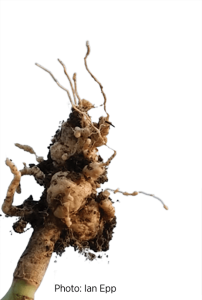Mapping the spread of clubroot
KEY RESULT:
A set of clubroot surveillance practices was developed for effective monitoring of the occurrence and severity of P. brassicae in commercial fields.
PROJECT TITLE, PRINCIPAL INVESTIGATOR:
“Clubroot surveillance and epidemiology,” Stephen Strelkov, University of Alberta
FUNDING:
Growing Forward 2
 Clubroot, we’re watching you. A major focus of research into clubroot disease caused by Plasmodiophora brassicae is surveillance of the geographic spread of the disease, and developing an understanding of the pathotypes causing the disease.
Clubroot, we’re watching you. A major focus of research into clubroot disease caused by Plasmodiophora brassicae is surveillance of the geographic spread of the disease, and developing an understanding of the pathotypes causing the disease.
Clubroot first emerged as an issue in canola on the prairies in 2003, when 12 clubroot-infested fields were identified in central Alberta. By 2013, more than 1,400 clubroot infestations were confirmed in the province. The objectives of this research were to monitor clubroot infestations to see how prevalent it is in particular regions, and how quickly clubroot is spreading. In addition, the research tracked the predominant pathotypes or strains of P. brassicae on the Prairies, and looked at whether genetic resistance was holding up in the field.
Annual field surveys were conducted across Alberta from 2013 through 2017. The majority of fields were visited shortly after swathing from late August to September, and had either not been inspected for clubroot previously or had been inspected and found to be free of the disease.
Using 2017 survey results as an example of the importance of the research findings, a survey of 554 canola crops in central and southern Alberta resulted in the identification of 72 new cases of the disease. These included the first records of clubroot in Big Lakes County, Brazeau County, Lac La Biche County, the County of Paintearth and the Municipal District (M.D.) of Wainwright. The identification of clubroot in Big Lakes County was particularly significant because it represented the first confirmed occurrence of the disease in the Peace Country of northwestern Alberta.
In addition to the 72 new cases of clubroot found in the Alberta-wide survey in 2017, a further 229 new records of the disease were confirmed in field inspections carried out by municipal and county personnel, for a total of 301 new clubroot-infested fields in 2017.
While most severely infested crops were confirmed to be susceptible canola hybrids, significant symptoms of clubroot were identified in at least 45 fields planted to resistant canola cultivars.
By the end of the study, a grand total of 2,744 clubroot-infested fields had been confirmed in Alberta since 2003. Since then, the number has continued to increase.
In addition to the clubroot surveillance in Alberta, 42 soil samples collected in Manitoba were evaluated for the presence of P. brassicae DNA by PCR analysis. Four root samples infected with P. brassicae were also collected in Saskatchewan and evaluated for pathotype designation.
Of the 42 soil samples received from Manitoba, only one tested positive for the presence of P. brassicae in 2017. The four populations from Saskatchewan in 2017 were not found to have pathotypes capable of overcoming resistance (three populations were classified as pathotype 3H, while one was classified as 5L).
The surveillance results are widely reported, and serve as a critical resource for understanding the nature and extent of the clubroot outbreak. In addition, the material collected and characterized as part of this work, along with the data on clubroot severity, serve as a foundation for nearly all other clubroot-related conducted in Canada.





